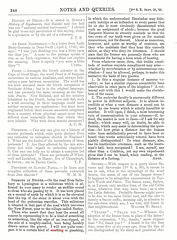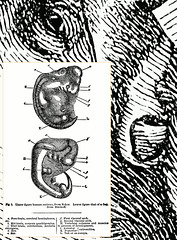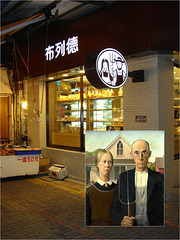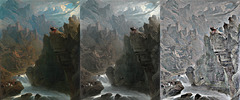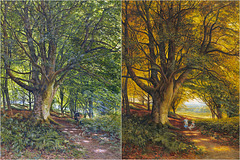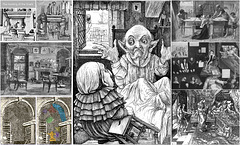Götz Kluge's photos
Snarking or Gnashing
| |
|
|
See also: www.academia.edu/10407335/Scratching_or_Scranching_is_not_quite_like_Snarking_or_Gnashing_1866_
SERMONS IN STONES. -- On the road from Salisbury to Lymington is a milestone which is affirmed by very many to render an audible sound to those who are passing by it. It has been placed on a mound of earth by which it is so far elevated that the top of the stone is about even with the head of the pedestrian traveller. This milestone is situated in that part of the road which traverses the New Forest, near to the village called Burley.
Those who assert that they hear the sound all concur in representing it to be a kind of scratching or scranching, like the edge of an iron-tipped, or the sole of a roughly-nailed, boot being harshly drawn across the gravel. I will not quite compare it to a certain kind of snarking or gnashing, in which the undercrushed Enceladus may hideously indulge as an indication to every passer that he or she is most virulently discontented with such an assignment of abode; because the good Emperor Marcus so sweetly reminds us that the two rows of our teeth were given us for mutual concurrence, not for discord. About as numerous, however, and quite as worthy of credence, are they who maintain that they hear this uncouth salute, as they who deny its utterance. I should state that the former are generally those who are remarkable for having a keen sense of hearing.
From whatever cause, then, this irelike crassitude of restless wayside compliment may arise whether by reverberation or by subterraneous concitation I may be allowed, perhaps, to make this narrative the basis of two queries.
1. Is this a singular instance of saxeous vocality; or has a similar cippous eccentricity been observable in other parts of the kingdom ? A collateral suit with this I would make the elucidation of the cause.
2. The auricular faculty is enormously different in power in different subjects. It is almost incredible at what a vast distance a sound can be heard by one hearer which is utterly inaudible to another. It will open, I think, a most interesting vein of communication in your columns if, in deed, the matter is new to them if I ask for any details; which many will, no doubt, be able to furnish, which may assist in determining the question At how great a distance has the human voice been satisfactorily proved to have been so heard that words articulately uttered have been plainly distinguished ? To what distance, also, has its inarticulate utterance, such as the huntsman's hail, been recognised ? I am, myself, any other than a Crichton, yet my own experiment gives that I can be heard, when reading, at the distance of a furlong.
* ANON.
Source: Notes and Queries (1866-09-29), Series 3, Volume 10, p. 248
doi: 10.1093/nq/s3-X.248.248-f
archive.org/stream/s3notesqueries10londuoft/s3notesqueries10londuoft_djvu.txt
Fun with Allusions
| |
|
|
I think that Henry Holiday had quite some fun in imagining how the beholders of his illustrations would deal with what they might see. And the cannot hold him responsible for what they see.
Firehouse in Tainan
| |
|
|
Taiwan
tainancity.wordpress.com/2009/12/19/fire-brigade-old-tainan-joint-government-offices
Ear & Embryo
| |
|
|
Background: Rotated detail from an illustration by Henry Holiday to Lewis Carroll's The Hunting of the Snark
Foreground: From Charles Darwin's The Descent of Man
- en.wikipedia.org/wiki/The_Descent_of_Man,_and_Selection_in_Relation_to_Sex
- commons.wikimedia.org/wiki/Descent_of_Man_%28A._L._Burt_edition%29
The Banker is one of the members of the Snark hunting party. Henry Holiday can draw ears. If the Banker's ear looks strange it is meant to look strange.
布列德
The Banker and The Bonnetmaker
| |
|
|
John Martin's Bard and Henry Holiday's Snark Illus…
| |
|
|
|
top left: John Martin, The Bard (1817).
top right: John Martin, The Bard modified using GIMP, Retinex: Scale=160, ScaleDivision=6, Dynamic=2.5
bottom left: Illustration (1876) by Henry Holiday to Lewis Carroll's The Hunting of the Snark , Fit 8. Changes: GIMP "delate" applied in order to yield a less darker printing.
bottom right: Illustration (1876) by Henry Holiday to Lewis Carroll's The Hunting of the Snark , Fit 5
4800 px × 6500 px
20.3 cm × 27.5 cm (@ 600 dpi)
=====================================================
John Martin: The Bard
ca. 1817
Yale Center for British Art, Paul Mellon Collection
collections.britishart.yale.edu/vufind/Record/1671616 :
"Based on a Thomas Gray poem, inspired by a Welsh tradition that said that Edward I had put to death any bards he found, to extinguish Welsh culture; the poem depicts the escape of a single bard.
In mydailyartdisplay.wordpress.com/the-bard-by-john-martin , "Jonathan" connects the painting to the poem The Bard written by by Thomas Gray in 1755:
· · ...
· · On a rock, whose haughty brow
· · Frowns o'er cold Conway's foaming flood,
· · Robed in the sable garb of woe
· · With haggard eyes the Poet stood;
· · ...
· · "Enough for me: with joy I see
· · The diff'rent doom our fates assign.
· · Be thine Despair and sceptred Care;
· · To triumph and to die are mine."
· · He spoke, and headlong from the mountain's height
· · Deep in the roaring tide he plunged to endless night.
· · ...
The poem and the painting may have been an inspiration to Lewis Carroll and Henry Holiday in The Hunting of the Snark:
· · 545 · · Erect and sublime, for one moment of time.
· · 546· · · · In the next, that wild figure they saw
· · 547· · (As if stung by a spasm) plunge into a chasm,
· · 548· · · · While they waited and listened in awe.
Album:
John Martin
John Martin' s "The Bard" prepared for analysis
| |
|
|
Source of the painting on the left side:
deliver.odai.yale.edu/content/id/594cf828-e6b8-4ec4-bf14-cac45880305d/format/3
left: John Martin, The Bard
center: desaturated, increased contrast of large dark area (rocks) on the right side
right: GIMP, Retinex filtering: Scale=160, ScaleDivision=6, Dynamic=2.5
=====================
John Martin: The Bard
ca. 1817
Yale Center for British Art, Paul Mellon Collection
collections.britishart.yale.edu/vufind/Record/1671616 :
"Based on a Thomas Gray poem, inspired by a Welsh tradition that said that Edward I had put to death any bards he found, to extinguish Welsh culture; the poem depicts the escape of a single bard.
In mydailyartdisplay.wordpress.com/the-bard-by-john-martin , "Jonathan" connects the painting to the poem The Bard written by by Thomas Gray in 1755:
· · ...
· · On a rock, whose haughty brow
· · Frowns o'er cold Conway's foaming flood,
· · Robed in the sable garb of woe
· · With haggard eyes the Poet stood;
· · ...
· · "Enough for me: with joy I see
· · The diff'rent doom our fates assign.
· · Be thine Despair and sceptred Care;
· · To triumph and to die are mine."
· · He spoke, and headlong from the mountain's height
· · Deep in the roaring tide he plunged to endless night.
· · ...
The poem and the painting may have been an inspiration to Lewis Carroll and Henry Holiday in The Hunting of the Snark:
· · 545 · · Erect and sublime, for one moment of time.
· · 546· · · · In the next, that wild figure they saw
· · 547· · (As if stung by a spasm) plunge into a chasm,
· · 548· · · · While they waited and listened in awe.
Album:
John Martin
The second Snark finding
About my Snark hunt
| |
|
|
===== How I got into Snark hunting =====
In December 2008, I searched for “Hidden Faces” in the Wikipedia . I wanted to see whether an illustration by Henry Holiday (left) to Lewis Carroll’s The Hunting of the Snark was mentioned there. (Now it is.) But instead of that I found Gheeraert's Allegory of Iconoclasm (right, aka The Image Breakers ) in the Wikipedia article on hidden faces. And then I saw a little rhombic pattern in the “mouths” of the “heads” depicted in both illustrations. The Snark hunt had begun.
left:
2009: Illustration by Henry Holiday to fit the eight in Lewis Carroll's The Hunting of the Snark
(This is the 2007 version of an image in ebooks.adelaide.edu.au/c/carroll/lewis/snark/#fit8 .)
center:
2008-12-16: Detail from "Hidden Faces" in en.wikipedia.org,
en.wikipedia.org/w/index.php?title=Hidden_faces&oldid=258354510
right:
Marcus Gheeraerts the Elder, Allegory of Iconoclasm , c.1566–1568 etching 15” x 10.4”, British Museum, London.
commons.wikimedia.org/wiki/File:Gheerhaets_Allegory_iconoclasm.jpg
(In December 2008 the image was smaller: upload.wikimedia.org/wikipedia/commons/archive/f/f5/20100214083045!Gheerhaets_Allegory_iconoclasm.jpg , but even there you can see the detail which cought my attention.)
(The blur is intentional. It removes unecessary details.)
Dancing in Rio 2016
| |
|
|
|
=== left ===
Logo of Olympic games, Rio 2016
=== right ===
Artist: Henri Matisse
Year: 1909
Type: Oil on canvas
Dimensions: 259.7 cm × 390.1 cm (102.2 in × 153.6 in)
Location: Museum of Modern Art, New York City
Source: en.wikipedia.org/wiki/Dance_%28Matisse%29#mediaviewer/File:La_danse_%28I%29_by_Matisse.jpg (uploaded by Fentener van Vlissingen)
See also: www.ipernity.com/doc/laurieannie/24054645
=== Links ===
¤ Discussion: www.google.com/search?q=danse+matisse+olympic+2016
¤ Images: www.google.com/search?q=danse+matisse&num=100&source=lnms&tbm=isch&sa=X
Holiday - Millais - Anonymous - Galle; detail
| |
|
|
|
#1, left - (allusion to the bedpost #3): 1876, Henry Holiday (engraver: Joseph Swain): The illustration detail on the very left side is a vectorized scan from Holiday's illustration to an 1910 edition of Lewis Carroll's The Hunting of the Snark .
#1, right: Additionally you see a segment from Holiday's preperatory draft.
#2 - (allusion to the bedpost #3 and to Philip Galle's print #4): 1850, the young John the Baptist in John Everett Millais : Christ in the House of His Parents (aka The Carpenter's Shop ). The left leg of the boy looks a bit deformed. This is no mistake. Probably Millais referred to #3 and to #4.
#3 - (Henry VIII's bedpost): 16th century, anonymous: Redrawn segment of Edward VI and the Pope, An Allegory of Reformation , (mirror view).
#4 - (bedpost #3 alludes to bedpost #4): 1564, Redrawn segment of a print Ahasuerus consulting the records by Philip Galle after Maarten van Heemskerck. The resemblance of #4 to the image #3 (the bedpost) was shown by the late Dr. Margaret Aston in 1994 in The King's Bedpost: Reformation and Iconography in a Tudor Group Portrait (p. 68). She also compared the bedpost to Heemskerck's Esther Crowned by Ahasuerus .
Bonomi Edward Warren: Variations on Trees and Shad…
| |
|
|
|
Bonomi Edward Warren (1842-1922, active 1860-1877):
¤ left: Sportsman and dog on a wooded path (1868, 68 x 51 cm, watercolor and gouache heightened with white)
¤ right: Woodland Scene in Summer with Children on a Path (1871, 120 x 89 cm, oil on canvas)
Not only the trees but also the shadows (e.g. on the path in the foreground) are similar.
(There is not too much information about this artist available in the internet.)
Eagle and Star
| |
|
|
[top segments]: Anonymous (1674), Fig. 4/4 to the orartie van de Professor L. Wolsogen over syndroom en de nytlegging van de felue gadaen ... . The animals are based on illustrations by M. Gheeraerts the Elder to Aesop's Fables. (Print now is located at British Museum, BM Satires 1047, reg.no.: 1868,0808.3286)
[bottom segments]: Henry Holiday (1876), illustration to Lewis Carroll's The Hunting of the Snark (woodcut by Joseph Swain)
The Baker's Dear Uncle
| |
|
|
In Henry Holiday's illustrations to Lewis Carroll's The Hunting of the Snark I found that Holiday constructed his illustrations as pictorial puzzles by quoting elements from paintings and illustrations of earlier artists (three images on the right side of the comparison image shown above). Holiday assimilated these elements into his Snark illustrations. But I also found that Alfred Parsons may have quoted elements from one of Holiday's illustrations.
For more, click on the images in the comment below.
Darwins snarked Study
| |
|
|
|
Alfred Parsons' depiction of Charles Darwin's study in Downe. The wood cutter was J. Tynan.
I assume that Alfred Parsons quoted shapes from Henry Holiday's illustration (cut by Joseph Swain) to The Bakers Tale in Lewis Carroll's The Hunting of the Snark in a similar manner as Henry Holiday used shapes in the works of earlier artists perhaps in order to "point" to these works. The match of each single shape could be quite incidental, but the the spacial relation of most shapes to each other also matches well. That is less likely to be just incidental.
(Alfred Parsons' depiction of Charles Darwin's new study is used here with permission by Dr. John van Wyhe, darwin-online.org.uk/. Henry Holiday's illustration has been scanned from a book published in 1911.)
This is one of the images which I posted on Flickr a few years ago. It is an earlier version of the image below:
The Boojum even may lurk on a ginger nuts tin.
| |
|
|
|
·
Hidden images (e.g., among others, the cannabis plants...) sometimes are hidden just for fun.
From severnbeachantiques.com/famous-rare-1980-huntley-and-palmer-rude-garden-party-ginger-nuts-tin you learn about one among many reasons why artist hide images in images:
"I did them out of devilment, purely for a laugh. I've always been a bit of a naughty boy but I've nothing against Huntley & Palmers . There have been rumours that I got made redundant and did it out of revenge. But that's not true - I was only ever a freelance. I just felt like adding a bit of smut to the proceedings."
That is what Artist Mick Hill said about his hidden surprises in the cover (1980) of a Huntley and Palmer garden party ginger nuts tin.
Paradise Lost and the Beaver's Lesson
| |
|
|
|
The comparison shows illustrations [left side] by Gustave Doré (to John Milton's Paradise Lost , Book VI, 1866 and [center] by Henry Holiday (to The Hunting of the Snark , 1876).

